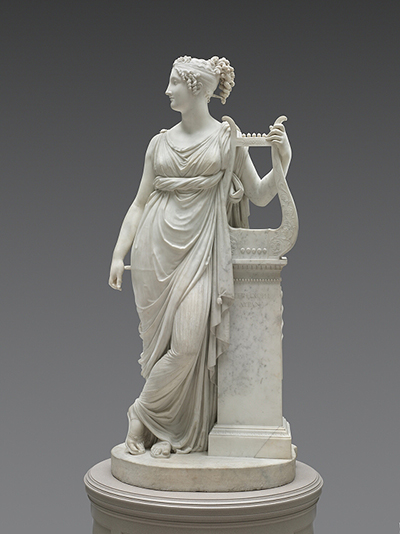The Muse Terpsichore was commenced by Antonio Canova in the early 19th century and would consist of several plaster models and a number of completed marble sculptures. The items now reside in various collections across Europe and the US, and the group helps us to better understand his working methods.
Terpsichore is the subject of this piece. She is the muse of dance and choral singing, hence the instrument which accompanies her on her right. Her left hand is wrapped around the lyre, which adds a symbolic and artistic interest to the overall piece. There are two plaster pieces in existence, plus two marble versions which followed soon afterwards. All have been successfully attributed to Canova specifically, even though he ran his own prominent studio. The plaster model of Terpsichore in the Villa Carlotta has perhaps received the most exposure and interest over recent years, perhaps because of its prominence within their overall collection which is smaller than some of the other institutions in which the artist's other items are found. Napoleon's younger brother requested that his wife would be used for this sculpture, with it essentially serving as a portrait of her. It was specifically Alexandrine de Bleschamp who was the wife of Lucien Bonaparte, and the entire Bonaparte family is believed to have been behind this request, with Canova well known to them having completed a number of other commissions already - see Bust (Colossal Head) of Napoleon Bonaparte, Napoleon as Mars the Peacemaker and Letizia Ramolino Bonaparte.
Some of the plaster versions still display clear traces of Canova's handy work, a little similar to how brush work can be visible on some old master paintings. Canova would work initially from a clay model in order to flesh out his idea, working with a medium which was suited to regular amendments at this early stage. He would also perhaps start with drawings, even before the clay stage and was a highly regarded draughtsman as well. The clay would be covered with plaster to produce the initial cast on the outside, with the clay then removed and a further set of plaster then added in its place. This produced the finished plaster piece that would be near identical to the original clay design. The method is generally known as lost casting and allowed the artist to make changes throughout the development process as he worked on his initial ideas and progressed them over time. Canova would typical remove and destroy the external cast, though this part of the process required great care in order to make the separation as effective as possible.
The Villa Carlotta, where one of the plaster casts can be seen in person, sits in the Italian town of Tremezzo, Como. There is a wealth of classical sculpture to be enjoyed here, aside from the piece discussed here. For example, you will also be able to find works by the likes of Bertel Thorvaldsen, whose own career was strongly linked to that of Canova. The building itself is also a breaktaking piece of architecture, placed alongside Lake Como in an incredibly picturesque location. Many visitors will actually make the trip even with little interest in sculpture, such is the quality of the venue and the other services that remain on offer here. Whilst most attention is rightly offered to the more prominent Italian art galleries and museums which are found in the likes of Florence, Venice and Milan, there is also a good number of important provincial collections to be found dotted around the country which normally receive visitors who are in the area at the time and take the opportunity to discover more of the country's artistic history whilst close by. It was Giovanni Battista Sommariva who set up the museum in the early 1880s and these two artists were amongst his early purchases, with most items still remaining in the growing collection today.




